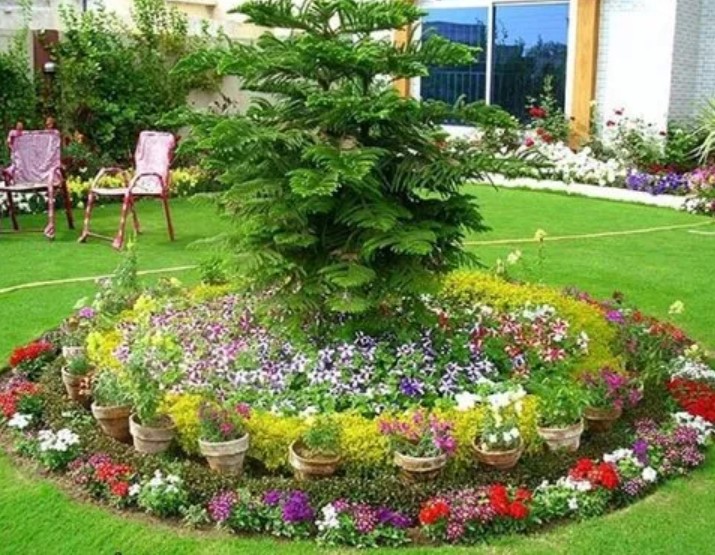Flower gardens are awe-inspiring expressions of nature’s splendor, captivating observers with a symphony of hues, delicate scents, and intricate patterns. Beyond mere floral arrangement, crafting a flower garden entails fashioning a cohesive sanctuary that mirrors one’s character, evokes sentiments, and nurtures biodiversity. Whether one is a seasoned horticulturist or a budding enthusiast, mastering the craft of flower garden design promises a fulfilling expedition brimming with beauty, serenity, and a profound connection to the environment.
Foundational Principles:
Before plunging into the depths of flower garden design intricacies, it is paramount to internalize the fundamental tenets that underpin successful garden layouts.
Site Evaluation:
- Thoroughly assess the garden’s locale, considering sun exposure, soil composition, drainage patterns, and existing landscape features.
- Define the garden’s purpose, whether it is to enhance curb appeal, beckon pollinators, or fashion a tranquil retreat.
Design Components:
- Acquaint oneself with essential design components such as color palettes, textures, forms, and proportions.
- Grasp the interplay of these elements in crafting visually captivating compositions that evoke specific emotions.
Plant Selection:
- Carefully curate plant species suited to the climate zone, soil quality, and available light conditions.
- Consider factors like bloom cycles, mature heights, and growth habits to ensure a harmonious and coherent garden design.
Crafting Your Flower Garden:
With the groundwork laid, it is time to embark on the creative voyage of shaping your flower garden. Follow these steps to breathe life into your vision:
Define Your Aesthetic:
- Explore diverse garden styles—formal, cottage, wildflower, contemporary—and discern the one that resonates with your aesthetic sensibilities.
- Derive inspiration from admired gardens, whether the structured allure of a French parterre or the whimsical allure of an English cottage garden.
Blueprint Creation:
- Sketch a rudimentary layout of the garden space, integrating existing features like trees, walkways, and structures.
- Establish focal points, pathways, and delineations within the garden to foster a sense of fluidity and order.
Harmonize Color Schemes:
- Curate a unified color palette harmonizing with the garden’s surroundings and reflecting the desired ambiance.
- Experiment with combinations of complementary or analogous hues to infuse visual allure and contrast.
Layering Plants Strategically:
- Arrange plants in graduated tiers based on their stature, positioning taller specimens towards the rear and diminutive ones towards the front.
- Infuse various plant shapes, sizes, and textures to imbue depth and dimensionality into the garden beds.
Embrace Seasonal Diversity:
- Strategize for year-round allure by incorporating plants boasting blooms, foliage, or structural interest across different seasons.
- Integrate seasonal bulbs, annuals, and perennials to ensure a dynamic tapestry of color and texture.
Integration of Hardscape Features:
- Elevate the allure of your flower garden with hardscape elements such as walkways, borders, trellises, and seating nooks.
- Employ materials like stone, wood, or metal to introduce visual contrast and architectural intrigue to the garden milieu.
Attention to Proportions:
- Uphold a sense of equilibrium and proportionality by spacing plants judiciously and circumventing overcrowding.
- Allow ample room for plants to mature and spread, factoring in their ultimate dimensions and growth trajectories.
Sustaining Your Flower Garden:
Embarking on a flower garden design journey is but the commencement; consistent maintenance is imperative to safeguard its enduring health and allure. Adhere to these guidelines to nurture your garden:
Prudent Water Management:
- Water plants deeply and infrequently, ensuring consistent soil moisture sans waterlogging.
- Implement drip irrigation systems or soaker hoses for targeted water delivery, minimizing water wastage through evaporation.
Regular Mulching:
- Apply a layer of organic mulch—shredded bark, compost—to suppress weeds, retain moisture, and regulate soil temperatures.
- Renew mulch annually to replenish nutrients and sustain its efficacy.
Pruning and Deadheading:
- Prune shrubs and perennials as warranted to excise dead or diseased growth, foster air circulation, and preserve desired shapes.
- Regularly deadhead spent blooms to prolong flowering and stimulate repeat blossoming throughout the season.
Balanced Fertilization:
- Nourish plants with a balanced fertilizer tailored for flowering specimens, adhering to recommended application rates and timings.
- Refrain from excessive fertilization, which may engender disproportionate foliage growth at the expense of blooms.
Vigilance Against Pests and Diseases:
- Maintain vigilance for signs of pest incursions or disease manifestations, such as discolored foliage, wilting, or aberrant growth patterns.
- Whenever feasible, resort to organic pest control methodologies, including manual removal, application of insecticidal soap, or introduction of beneficial insects.
Rotational Cultivation and Division:
- Periodically rotate annual and perennial plantings to forestall soil depletion and mitigate the risk of disease proliferation.
- Divide overcrowded perennials at intervals to invigorate them and sustain their vitality.
In Conclusion:
Designing a flower garden is a profoundly gratifying pursuit. It affords opportunities to unleash creativity, commune with nature, and instill beauty in outdoor spaces. By assimilating garden design principles, selecting suitable flora, and executing meticulous upkeep, one can fashion a resplendent floral haven that delights the senses and yields boundless joy across seasons. Roll up your sleeves, delve into the earth, and allow your imagination to blossom as you embark on the odyssey of flower garden design.

